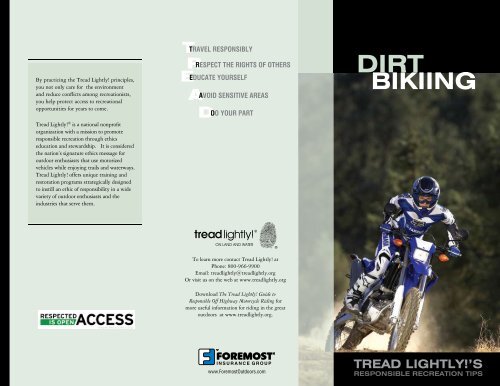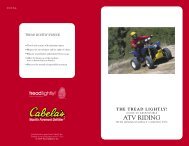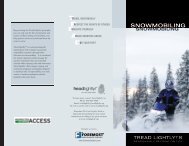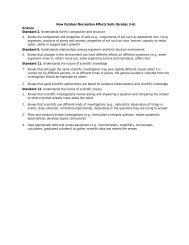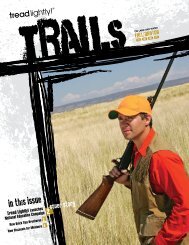BIKIING - Tread Lightly
BIKIING - Tread Lightly
BIKIING - Tread Lightly
Create successful ePaper yourself
Turn your PDF publications into a flip-book with our unique Google optimized e-Paper software.
By practicing the <strong>Tread</strong> <strong>Lightly</strong>! principles,<br />
you not only care for the environment<br />
and reduce conflicts among recreationists,<br />
you help protect access to recreational<br />
opportunities for years to come.<br />
<strong>Tread</strong> <strong>Lightly</strong>! ® is a national nonprofit<br />
organization with a mission to promote<br />
responsible recreation through ethics<br />
education and stewardship. It is considered<br />
the nation’s signature ethics message for<br />
outdoor enthusiasts that use motorized<br />
vehicles while enjoying trails and waterways.<br />
<strong>Tread</strong> <strong>Lightly</strong>! offers unique training and<br />
restoration programs strategically designed<br />
to instill an ethic of responsibility in a wide<br />
variety of outdoor enthusiasts and the<br />
industries that serve them.<br />
T<br />
R<br />
E<br />
A<br />
D<br />
TRAVEL RESPONSIBLY<br />
RESPECT THE RIGHTS OF OTHERS<br />
EDUCATE YOURSELF<br />
AVOID SENSITIVE AREAS<br />
DO YOUR PART<br />
DIRT<br />
<strong>BIKIING</strong><br />
ON LAND AND WATER<br />
To learn more contact <strong>Tread</strong> <strong>Lightly</strong>! at<br />
Phone: 800-966-9900<br />
Email: treadlightly@treadlightly.org<br />
Or visit us on the web at www.treadlightly.org<br />
Download The <strong>Tread</strong> <strong>Lightly</strong>! Guide to<br />
Responsible Off Highway Motorcycle Riding for<br />
more useful information for riding in the great<br />
outdoors at www.treadlightly.org.<br />
TREAD LIGHTLY!’S<br />
RESPONSIBLE RECREATION TIPS
TRAVEL RESPONSIBLY<br />
Travel responsibly on designated roads,<br />
trails or areas.<br />
aa Travel only in areas open to dirt bikes.<br />
aa Minimize wheel spin.<br />
aa On switchbacks, avoid roosting around the<br />
apex of the turn when climbing or brake-sliding<br />
during descent, both of which gouge the trail.<br />
aa Drive over, not around obstacles to avoid<br />
widening the trail.<br />
aa Slow down when site lines are poor.<br />
aa Cross streams only at designated fording points,<br />
where the trail crosses the stream.<br />
aa Comply with all signs and barriers.<br />
aa Buddy up with two or three riders, reducing<br />
vulnerability if you have an accident or<br />
breakdown. Designate meeting areas in case of<br />
separation.<br />
aa Listening to headphones or ear buds can make<br />
it difficult to hear and communicate with other<br />
recreationists. In some areas it is illegal to<br />
operate dirt bikes with both ears covered.<br />
aa Don’t mix riding with alcohol or drugs.<br />
RESPECT THE RIGHTS OF OTHERS<br />
Respect the rights of others including<br />
private property owners, all recreational<br />
trail users, campers and others to allow<br />
them to enjoy their recreational activities<br />
undisturbed.<br />
aa Do not ride around in camping, picnicking,<br />
trailhead, and residential areas.<br />
aa Keep speeds low around crowds and in<br />
camping areas.<br />
aa Keep the noise and dust down.<br />
EDUCATE YOURSELF<br />
Educate yourself prior to your trip, by<br />
obtaining travel maps and regulations<br />
from public agencies, planning for your<br />
trip, taking recreation skills classes, and<br />
knowing how to use and operate your<br />
equipment safely.<br />
aa Obtain a map, motor vehicle use map where<br />
appropriate, of your destination and determine<br />
which areas are open to dirt bikes.<br />
aa Make a realistic plan, and stick to it. Always<br />
tell someone of your travel plans.<br />
aa Contact the land manager for area restrictions,<br />
closures, and permit requirements.<br />
aa Check the weather forecast before you go.<br />
aa Prepare for the unexpected by packing a small<br />
backpack full of emergency items.<br />
aa Wear a helmet, eye protection, and other safety<br />
gear.<br />
aa Know your limitations. Watch your time, your<br />
fuel, and your energy.<br />
aa<br />
A DirtBike School SM class provides a fast-paced,<br />
half-day, hands-on training session. Call<br />
1-877- 288-7093 to enroll.<br />
aa Make sure your vehicle is mechanically up to<br />
task. Be prepared with tools, supplies, spares,<br />
and a spill kit for trailside repairs.<br />
DO YOUR PART<br />
Do your part by modeling appropriate<br />
behavior, leaving the area better than<br />
you found it, properly disposing of waste,<br />
minimizing the use of fire, avoiding the<br />
spread of invasive species, and restoring<br />
degraded areas.<br />
aa Carry a trash bag on your vehicle and pick<br />
up litter left by others.<br />
aa Pack out what you pack in.<br />
aa Practice minimum impact camping by using<br />
established sites and camping 200 feet from<br />
water resources and trails.<br />
aa Observe proper sanitary waste disposal or<br />
pack your waste out.<br />
aa Spark arrestors are required on all OHV’s<br />
traveling on public lands.<br />
aa Prevent unnecessary noise created by a<br />
poorly tuned vehicle or revving your engine.<br />
Use proper silencers on exhausts, that meet<br />
regulatory decibel levels.<br />
aa Before and after a ride, wash your dirt bike<br />
and support vehicle to reduce the spread of<br />
invasive species.<br />
aa Build a trail community. Get to know<br />
other types of recreationists that share your<br />
favorite trail.<br />
aa Be considerate of others on the road or trail.<br />
aa Leave gates as you find them.<br />
aa If crossing private property, be sure to ask<br />
permission from the landowner(s).<br />
aa Yield the right of way to those passing you or<br />
traveling uphill. Yield to mountain bikers,<br />
hikers, and horses.<br />
aa Around horses and pack animals proceed with<br />
caution. Sudden, unfamiliar activity may<br />
spook animals—possibly causing injury to<br />
animals, handlers, and others on the trail.<br />
aa When encountering horses on the trail, move<br />
to the side of the trail, stop, turn off your<br />
engine, remove your helmet, and speak—you<br />
want the horse to know you are human. Ask<br />
the rider the best way to proceed.<br />
AVOID SENSITIVE AREAS<br />
Avoid sensitive areas such as meadows,<br />
lakeshores, wetlands and streams. Stay on<br />
designated routes.<br />
aa Other sensitive habitats to avoid unless on<br />
designated routes include cryptobiotic soils<br />
of the desert, tundra, and seasonal nesting or<br />
breeding areas.<br />
aa Do not disturb historical, archeological, and<br />
paleontological sites.<br />
aa Avoid “spooking” livestock and wildlife you<br />
encounter and keep your distance.<br />
aa Motorized and mechanized vehicles are not<br />
allowed in designated Wilderness Areas.<br />
Cross streams<br />
slowly where the<br />
trail crosses stream!<br />
Ride over obstacles<br />
not around!


